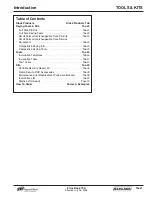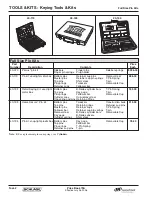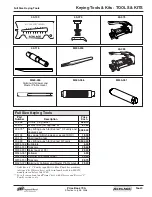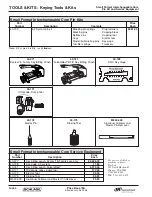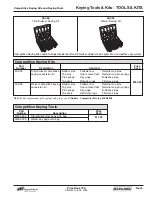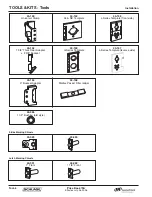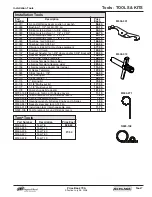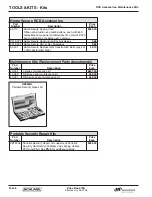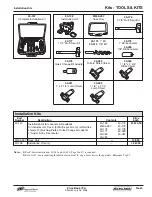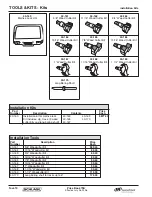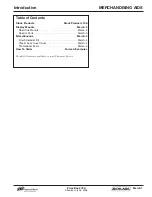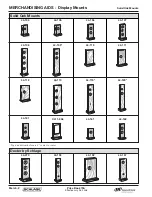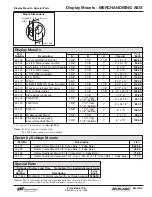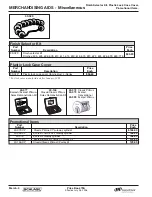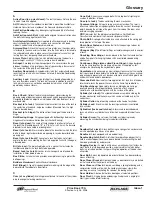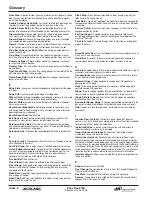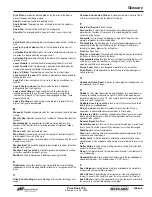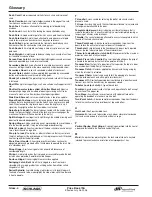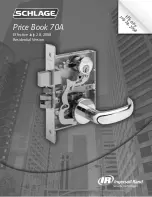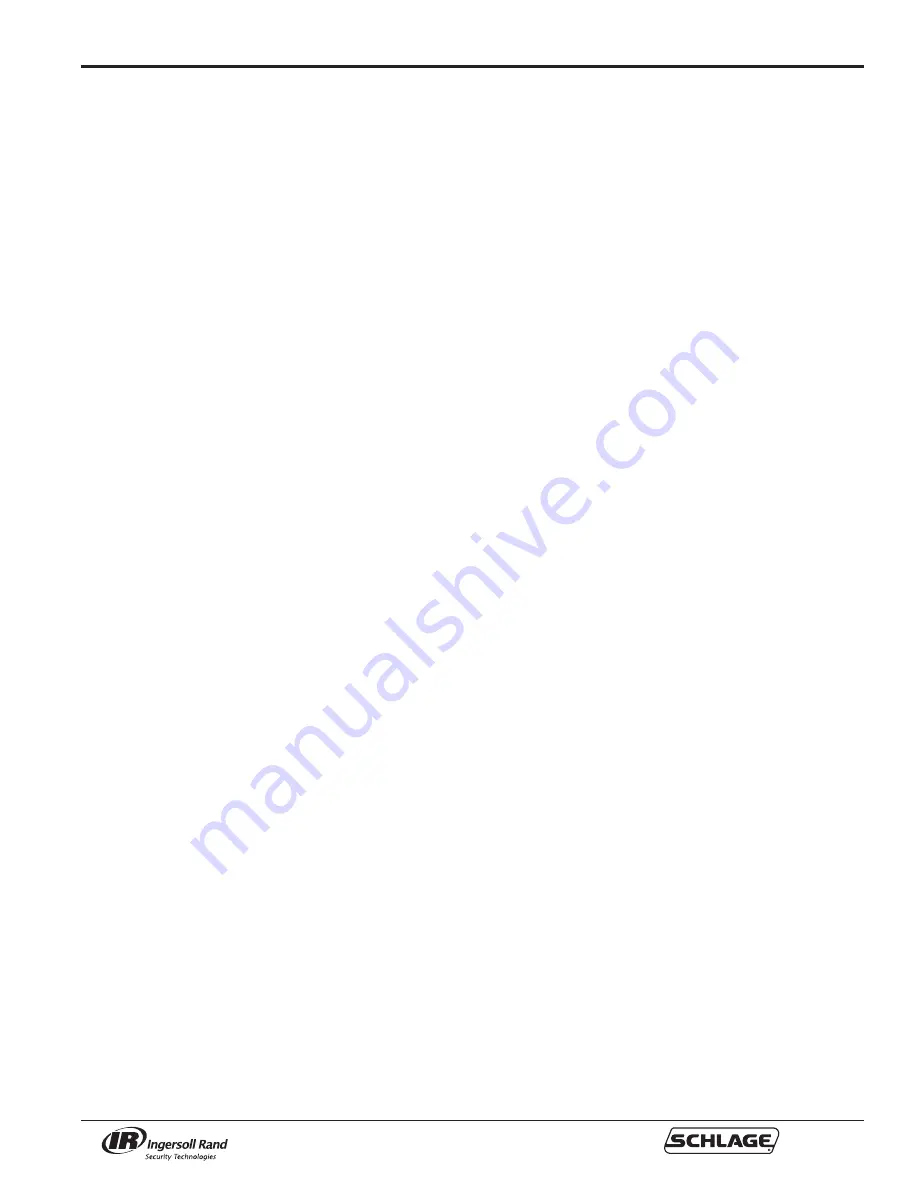
Gloss-1
Price Book 70A
Effective July 28, 2008
Glossary
A
Active Door (in a pair of doors): The leaf that opens first and the one
to which the lock is applied.
AHC: Indicates that the individual so identified is a qualified Architectural
Hardware Consultant and member of the Door and Hardware Institute.
Anti-Friction Bearing: Any bearing having the capability of effectively
reducing friction.
Anti-Friction Latch Bolt: A latch bolt de signed to reduce friction when
the bolt starts to engage the lock strike.
Architectural Hardware: Term applied to all hardware used in building
construction but particularly that used on or in connection with doors,
windows, cabinets and other movable members.
Armored Front: A lock that consists of two plates: one, the under plate,
is fastened to the case and is unfinished; two, the finish plate, is fastened to
the under plate and when in place covers the cylinder set screws thus pro-
tecting them from tampering. Used on mortise locks.
Armor Plate: A plate similar to a kick plate but covering the door to a
greater height, usually 40" (1040 mm) or more from the bottom.
Astragal: A molding or strip whose purpose is to cover or close the gap
between the edges of a pair of doors. Some types overlap, others meet at
the center line of the gap. (See Coordinator.)
Auxiliary Dead Latch: A supplementary latch that automatically dead-
locks the main latch bolt when the door is closed. (Also called Deadlocking
Latch Bolt.)
Auxiliary Lock: A lock having a latch bolt or a dead bolt operated by a
key or a thumbturn or both. This lock is often used in addition to another
lock, which may or may not be key operated but which has a latch bolt
operated by knobs or levers.
B
Back Check: Optional feature in hydraulic door closers slowing the
opening swing of door somewhere between 60 and 85 degrees of opening.
Designed to protect an object be hind the door. Not intended to act as an
overhead stop.
Backset (of a lock): The horizontal distance from the face of the lock to
the center line of knob hub, keyhole or cylinder. (Measured from the high
side of a beveled door.)
Backset (of a hinge): The distance from the edge of the door to the
hinge.
Ball-Bearing Hinge: A hinge equipped with ball bearings between the
hinge knuckles to reduce friction (See Anti-Friction Bearing.)
Bevel (of a door): The angle of the lock edge in relation to the face of
the lock stile. Standard bevel is 1/8" in 2" (3.2 mm in 50.8 mm). If otherwise
detailed it must be so noted in ordering locks.
Bevel (of a lock): A term used to indicate the direction in which the latch
bolt is in dined: regular bevel for doors opening in, reverse bevel for doors
opening out.
Bevel (of a lock front): The angle of a lock front when not at right
angle to the lock case, allowing the front to be applied flush with the edge of
a beveled door
Bit (of a key): The projecting blade, cut in a manner that actuates the
tumblers and permits the lock bolts to be operated.
Bored Lock (or Latch): Lock or latch whose parts are intended for
installation in holes bored in a door
Box Strike: A strike that also provides a complete housing to protect the
bolt openings.
Builders Hardware: See Architectural Hardware.
Butt (Hinge): A type of hinge designed for mortising into the edge of the
door and into the rabbet of a door frame.
C
Cam (of a cylinder): A rotating piece attached to the end of the cylinder
plug to engage the locking mechanism.
Cane Bolt: A heavy cane-shaped bolt with the top bent at right angles;
used on the bottom of doors.
Case (of a lock): The box containing the lock mechanism.
Casement Hinge: A hinge to swing a casement window. The term is
often used to describe a hinge designed to throw the sash out far enough to
permit cleaning the outside of the glass from the inside of the room on an
outward-swinging casement.
CDC: Indicates that the individual so identified is a Certified Door
Consultant and member of the Door and Hardware Institute.
Chain Bolt: A spring bolt actuated by a chain attached to the spring bolt
for application at the top of the door.
Chain Door Fastener: A device that limits the opening of a door by
means of a chain.
Changes (Key): The different bittings or tumbler arrangements in a series
of locks.
Checking Floor Hinge: A device placed in the floor that combines top
and bottom pivots for hanging the door with a controlled speed dosing
mechanism.
Continuous Hinge (also called Piano Hinge): A hinge designed
to be the same length as the moving part to which it is applied as, for
example, the lid covering the keyboard of a piano.
Coordinator: A device used on a pair of doors to ensure that the inactive
leaf is per mined to dose before the active leaf. Necessary when an overlap-
ping astragal is present and exit devices, automatic or self latching bolts are
used with closers on both door leaves.
Cremone Bolt: A device of surface application that, by a turn of knob or
lever handle, locks the door or the sash into the frame, top and bottom.
Cup Escutcheon: A door plate, for use on sliding doors, having a
recessed panel to afford finger hold and to contain a flush ring and
sometimes a cylinder, all being flush with the surface of the plate.
Cylinder (of a lock): The cylindrical-shaped assembly containing the
tumbler mechanism and the keyway, which can be actuated only by the
correct keys.
Cylinder Collar: A plate or ring used under the head of a cylinder.
Cylinder Lock: A lock in which the locking mechanism is controlled
by a cylinder.
Cylindrical (locks and latches): A term used to describe bored
locks, which have a cylindrical case into which a separate latch bolt case
fits.
Cylinder Screw: The set screw that holds a cylinder in place by
preventing the cylinder from being turned after installation.
D
Deadbolt (of a lock): A lock bolt having no spring acton nor bevel, and
which is operated by a key or a turn piece.
Deadlock: A lock equipped with a dead bolt only.
Deadlocking Latch Bolt: A latch bolt incorporating a plunger that is
held in a retracted position when a door is dosed, thus preventing the bolt
from being retracted by end pressure.
Dogging Device: As used in exit devices, a mechanism that fastens the
cross bar in the fully depressed position, and also retains the latch bolt or
bolts in a retracted position, thus permitting free operation of the door from
either side.
Door Bolt: A manually operated rod or bar attached to a door providing
means of locking.
Door Closer Bracket: A device whereby a door closer may be installed
on the frame rather than directly on the door.
Door Closer or Check: A device combining a spring for dosing and a
compression chamber into which the liquid or air escapes slowly, thus
providing a means of controlling the speed of the dosing action.
Door Holder: A device that holds a door open at selected positions.
Door Pivot: A hinging device embodying a fixed pin and a single joint.
Most types include lateral fastening.
Summary of Contents for A Series
Page 25: ...Price Book 70A Effective July 28 2008 BE FE 8 BE FE Series Keypad Locks ...
Page 33: ...B BA300 Series Notes Price Book 70 Effective February 25 2008 B BA300 8 ...
Page 43: ...F FA Series Handlesets Notes Price Book 70 Effective February 25 2008 F FA 10 ...
Page 57: ...F FA Series Parts Notes Price Book 70 Effective February 25 2008 F FA 24 ...
Page 62: ...7 by PRICE BOOK 70 Effective February 25 2008 NOTES by ...
Page 89: ...by PRICE BOOK 70 Effective February 25 2008 34 by Notes ...

